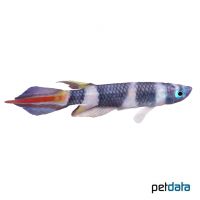Banded Panchax (Epiplatys annulatus)
| Banded Panchax Epiplatys annulatus | |
|---|---|
| Name | Banded Panchax |
| Name Lat. | Epiplatys annulatus |
| Synonym | Pseudepiplatys annulatus |
| Family | African Rivulines |
| Family lat. | Nothobranchiidae |
| Order | Killifishes & Livebearers |
| Order lat. | Cyprinodontiformes |
| Origin | Western Africa |
| Habitat | Streams |
| Diet | Carnivore |
| pH | 5.0-7.0 |
| Behavior | Peaceful |
| Keeping | Pair, harem |
| Care Level | Difficult |
| Reproduction | Substrate spawner |
| Breeding | Difficult |
| Life Span | 3-5 years |
| Protection | No |
| Metric Units | |
| Size | 4 cm |
| Temperature | 24-26 °C |
| Hardness | < 10 °dH |
| Aquarium | ~ 60 l |
| US Units | |
| Size | 1.6" |
| Temperature | 75-79 °F |
| Hardness | < 178 ppm |
| Aquarium | ~ 15 gal |
Distribution and habitat
The distribution area of the Ringed Pike is small, coastal waters in West Africa, from Guinea via Sierra Leone to Liberia. There they live in weedy ponds and pools as well as in slowly flowing watercourses with partly dense vegetation, branches and roots. There are several saddleback varieties that differ in coloration.
Maintenance
The aquarium should have dense planting, with hiding and retreat possibilities (roots) and provide sufficient swimming space. A dark substrate covered with some foliage (e.g. sea almond leaves), subdued light (floating plants) and soft, slightly acidic water is ideal
No ammonia, ammonium and nitrite should be detectable, the nitrate value should not exceed 100 mg/l. To ensure the water quality and oxygen content, a filter and heater adapted to the aquarium size is required, as well as lighting for the species-appropriate day-night rhythm of the animals.
Diet
In nature they feed mainly on insects and insect larvae. The food supply consists of live, frozen and dry food. For a balanced diet, feed once a day with a high-quality, protein-rich dry food (flakes, granules, micropellets) and with cyclops, moina, daphnia, artemia, mosquito larvae, etc. (live or frozen)
It is recommended to feed small portions several times a day. Only feed as much as will be eaten within a few minutes. A regular and varied diet promotes health and increases resistance.
Behaviour and compatibility
These peaceful and shy fish should be kept in pairs or better in a harem, one male with 2-3 females. Among themselves they occasionally behave territorially, so keeping several pairs is recommended only in a larger and richly structured tank. They can be well socialized with other small, calm and peaceful fish. Basically, only compatible fish species with similar demands on water condition and water temperature should be socialized.
Sex dimorphism
Adult males are more colorful and slightly larger than females and have a distinctly more pointed caudal fin; in females it is more rounded.
Reproduction and breeding
They are plant spawners, preferring to spawn their hard-shelled eggs with adhesive filaments on fine-feathered plants. No brood care is practiced. The fry hatch after 10-14 days depending on temperature.
Fry must be fed several times a day with special rearing food (Artemia nauplii, microworms, dust food). In a community tank breeding is hardly possible, because the spawn is easy prey.
Important
These non-annual killifish live in waters that hold water year-round
They like to jump, so the aquarium should be well covered.
The foliage (sea almond tree, oak, etc.) enriches the water with humic substances, naturally lowers the pH and when rotting promotes the development of microorganisms, which are a valuable secondary food source.
The well-being of the fish should be monitored regularly. Temperature should be checked daily, pH, hardness and nitrate levels at least every 14 days. Regular partial water changes are recommended, even when contaminant levels have not yet reached the upper limit. Sudden changes in water quality should be avoided. Newly introduced fish must be accustomed slowly to the water in the aquarium.
Further literature can be found in your pet store.
References
Text: Werner Winter; Image: petdata
Source: BMELV (1998): Tierschutzgutachten - Haltung von Zierfischen (Süßwasser); RIEHL & BAENSCH (2006): Aquarien Atlas Bd. 1, Mergus Verlag; RADDA & PÜRZL (1987): Colour Atlas of Cyprinodonts of the Rain Forests of Tropical Africa, Verlag Otto Hofmann; ENGELMANN (2005): Zootierhaltung - Tiere in menschlicher Obhut: Fische, Verlag Harri Deutsch
- Gemäß § 21 Abs. 5 Tierschutzgesetz idgF
